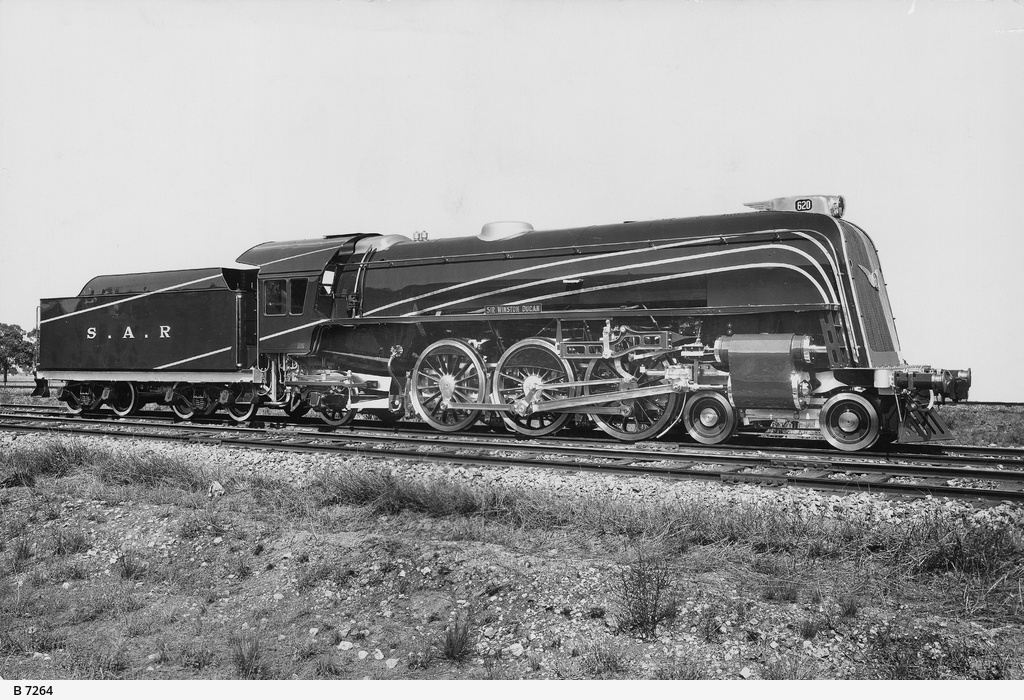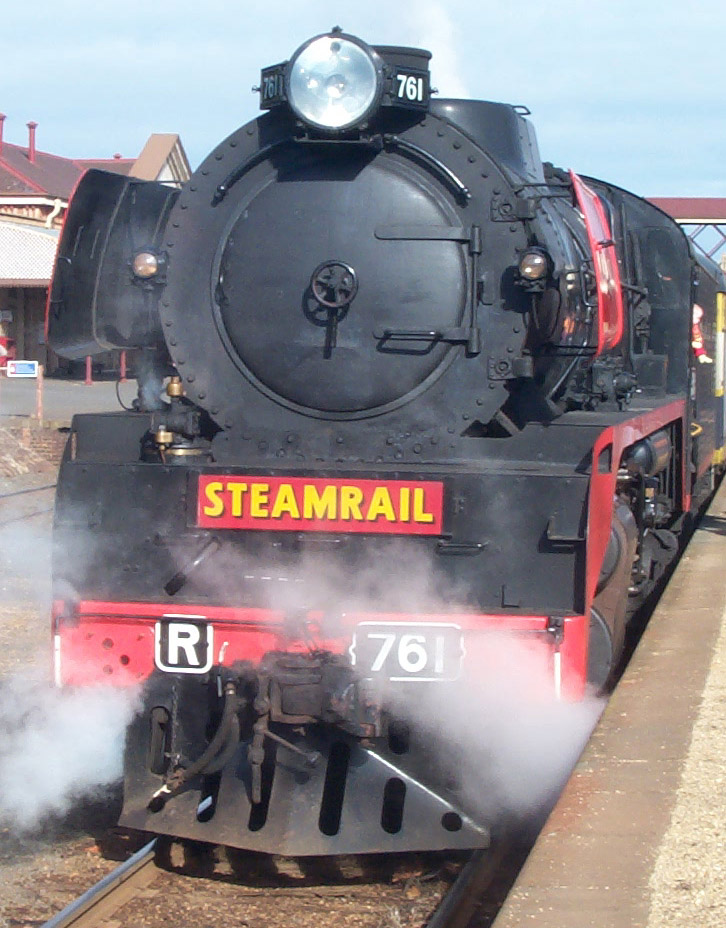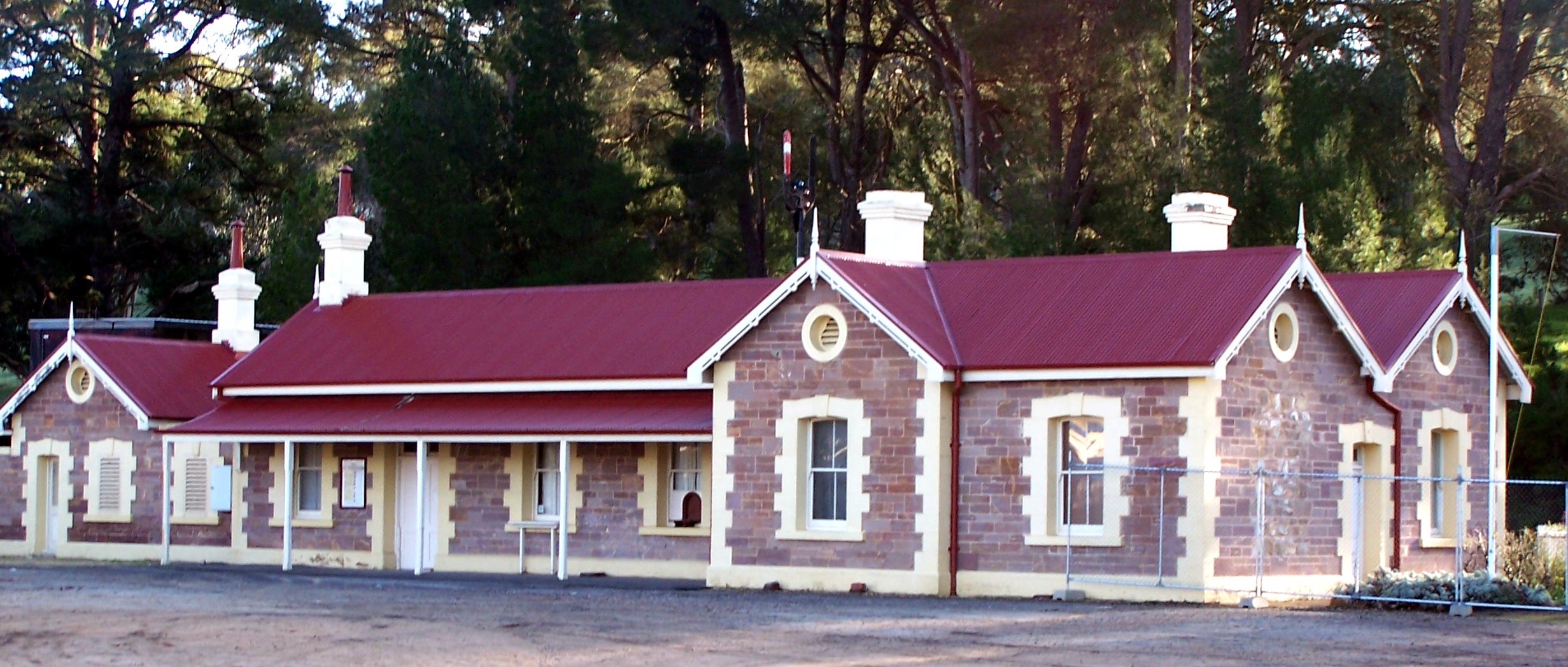|
South Australian Railways 620 Class
The South Australian Railways 620 class was a class of 4-6-2 steam locomotives operated by the South Australian Railways. History The completion of the South Australian Railway (SAR) broad gauge route between Adelaide and Port Pirie created a need for a fast, light passenger locomotive to haul this service, as well as other traffic on the lightly laid rail branch lines of the SAR. The specification included the ability to haul a train up a 1-in-45 (2.2%) grade at . Fred Shea, Chief Mechanical Engineer of the SAR designed a Pacific type. A notable feature of the design, unique to South Australian Railways, was the use of Baker valve gear in lieu of the more common Walschaerts valve gear. The first locomotive was completed at the Islington Railway Workshops in 1936, with the last completed in 1938. Class leader 620 was also notable for being Australia's first streamlined locomotive, the smokebox being covered with a chromed steel grille similar to those fitted to motor cars o ... [...More Info...] [...Related Items...] OR: [Wikipedia] [Google] [Baidu] |
Islington Railway Workshops
The Islington Railway Workshops are railway workshops in the northern suburbs of Adelaide, South Australia. They were the chief railway workshops of the South Australian Railways, and are still in operation today.Islington Railway Workshops SA Life History The Islington workshops were established in 1883, 27 years after the South Australian Railways opened its first line. Before that, workshops were in the yards adjacent to North Terrace, |
South Australian Railways 520 Class
The South Australian Railways 520 class is a class of 4-8-4 steam locomotives operated by the former South Australian Railways. Need During the war years in the early 1940s, the South Australian Railways (SAR) had a desperate need for additional tractive power on increasingly growing troop and supply trains and with the combined need for quick acceleration and high speed running on the flat and generally straight mainlines to the north of Adelaide to Port Pirie, as well as power "under the belt" for the long , 1-in-45 (2.2%) graded slog up the Adelaide Hills to Melbourne, a new locomotive design was required by the SAR. With this in mind, the 520 class was commissioned, combining the better features of the earlier 500 and 620 class locomotives. Design The class used the 4-8-4 configuration of the modified 500B class, but was also designed for work on branch lines with light rail with a reduced tender load. The considerable weight of the locomotive was spread over eight axles, ... [...More Info...] [...Related Items...] OR: [Wikipedia] [Google] [Baidu] |
Victorian Railways R Class
The R class was an express passenger steam locomotive that ran on Australia's Victorian Railways (VR) from 1951 to 1974. A long overdue replacement for the 1907-era A2 class 4-6-0, their development and construction was repeatedly delayed due to financial constraints caused by the Great Depression and later the manpower and materials shortages of World War II and the immediate postwar period. Orders eventually totalling 70 locomotives were placed with the North British Locomotive Company of Glasgow. Once initial teething problems were overcome, R class locomotives proved to be a success and their power and speed enabled faster timetabled services. However, they were almost immediately superseded by mainline diesel-electric and electric locomotives on the Victorian Railways from 1952 onwards. With successive orders of diesel-electric locomotives through the 1950s and 1960s gradually displacing them, all but seven of the class were withdrawn and cut up for scrap. Four of the rema ... [...More Info...] [...Related Items...] OR: [Wikipedia] [Google] [Baidu] |
Loading Gauge
A loading gauge is a diagram or physical structure that defines the maximum height and width dimensions in railway vehicles and their loads. Their purpose is to ensure that rail vehicles can pass safely through tunnels and under bridges, and keep clear of platforms, trackside buildings and structures. Classification systems vary between different countries, and gauges may vary across a network, even if the track gauge is uniform. The term loading gauge can also be applied to the maximum size of road vehicles in relation to tunnels, overpasses and bridges, and doors into automobile repair shops, bus garages, filling stations, residential garages, multi-storey car parks and warehouses. A related but separate gauge is the structure gauge, which sets limits to the extent that bridges, tunnels and other infrastructure can encroach on rail vehicles. The difference between these two gauges is called the clearance. The specified amount of clearance makes allowance for wobbling of ... [...More Info...] [...Related Items...] OR: [Wikipedia] [Google] [Baidu] |
Bacchus Marsh Railway Station
Bacchus Marsh railway station is located on the Serviceton line in Victoria, Australia. It serves the town of Bacchus Marsh, and it opened on 10 February 1887. A number of sidings once existed opposite the station and were used to stable trains. It also has an operational turntable, that is mainly used for turning steam locomotives on special trains. History Bacchus Marsh opened as the temporary terminus of the line from Melbourne. On 4 December 1889, the line was extended to Ballan, which completed the direct Melbourne to Ballarat line. The contract for the construction of the station building was awarded in 1889, for £1809/8/11. A 45 lever interlocking frame, in a signal box, was brought into use in 1890. By this time, the station had a main platform, with a dock platform at the eastern end, a main line and crossing loop, turntable, and a number of sidings. The station was originally provided with a turntable. In 1957, it was replaced by a 70-foot unit. s In the lat ... [...More Info...] [...Related Items...] OR: [Wikipedia] [Google] [Baidu] |
Track Gauge Conversion
Gauge conversion is the changing of one railway track gauge (the distance between the running rails) to another. Sleepers If tracks are converted to a narrower gauge, the existing sleepers (ties) may be used. However, replacement is required if the conversion is to a wider gauge. Some sleepers may be long enough to accommodate the fittings of both existing and alternative gauges. Wooden sleepers are suitable for conversion because they can be drilled for the repositioned rail spikes. Being difficult to drill, concrete sleepers are less suitable for conversion. Concrete sleepers may be cast with alternative gauge fittings in place, an example being those used during the conversion of the Melbourne–Adelaide railway from to . Steel sleepers may have alternative gauge fittings cast at production, may be drilled for new fittings or may be welded with new fittings. Structures Conversion from a narrow to a wider gauge may require enlargement of the structure gauge of the bridges, ... [...More Info...] [...Related Items...] OR: [Wikipedia] [Google] [Baidu] |
Victoria (Australia)
Victoria is a state in southeastern Australia. It is the second-smallest state with a land area of , the second most populated state (after New South Wales) with a population of over 6.5 million, and the most densely populated state in Australia (28 per km2). Victoria is bordered by New South Wales to the north and South Australia to the west, and is bounded by the Bass Strait to the south (with the exception of a small land border with Tasmania located along Boundary Islet), the Great Australian Bight portion of the Southern Ocean to the southwest, and the Tasman Sea (a marginal sea of the South Pacific Ocean) to the southeast. The state encompasses a range of climates and geographical features from its temperate coastal and central regions to the Victorian Alps in the northeast and the semi-arid north-west. The majority of the Victorian population is concentrated in the central-south area surrounding Port Phillip Bay, and in particular within the metropolit ... [...More Info...] [...Related Items...] OR: [Wikipedia] [Google] [Baidu] |
National Railway Museum, Port Adelaide
Australia's National Railway Museum is the largest railway museum in Australia. More than 100 major exhibits, mainly from the South Australian Railways (SAR) and Commonwealth Railways and their successor, Australian National Railways Commission, Australian National, are on display at its site in Port Adelaide, South Australia. The museum opened at Lipson Street in 1988 after 18 years at the SAR's former main locomotive depot at Mile End, South Australia, Mile End. History Mile End, 1964–1988 In 1963, a group of rail preservationists asked the South Australian Railways Commissioner to allocate land on the site of the former Mile End, South Australia, Mile End roundhouse to hold a small collection of withdrawn steam locomotives. The first locomotive arrived in 1964 and in 1970 the site opened as the Mile End Railway Museum. Only a few exhibits were under cover and the effects of weather took their toll; an alternative, under-cover venue was sought. Move to Port Adelaide In ... [...More Info...] [...Related Items...] OR: [Wikipedia] [Google] [Baidu] |
SteamRanger
The SteamRanger Heritage Railway is a long broad gauge tourist railway, formerly the Victor Harbor railway line of the South Australian Railways (SAR). It is operated by the not-for-profit South Australian Division of the Australian Railway Historical Society. As the last operating non-suburban line of the former broad-gauge network, on which Australia's first public railway was opened, the line and its associated rail assets have high historical significance. History In the 1970s, the South Australian Division of the Australian Railway Historical Society established SteamRanger as a not-for-profit railway preservation offshoot to operate its train tours from Adelaide, mainly on rural lines throughout the state's broad gauge networks. SteamRanger opened their first purpose-built depot at Dry Creek railway station, north of Adelaide in 1980. From the mid-1980's, SteamRanger gradually took over the operation & maintenance of the Victor Harbor railway line. When plans were an ... [...More Info...] [...Related Items...] OR: [Wikipedia] [Google] [Baidu] |
South Australian Railways Bluebird Railcar
The Bluebird railcars were a class of self-propelled diesel-hydraulic railcar built by the South Australian Railways' Islington Railway Workshops between 1954 and 1959. History The Bluebird railcars were built to provide modern air-conditioned services on the country passenger rail system where the patronage did not warrant the use of locomotive hauled passenger trains, and to replace the ageing fleet of Brill railcars introduced in 1924. In December 1948, tenders were called for 30 sets of engines, gearboxes, electrical assemblies and compressors. The contract for the engines was awarded to Cummins while the contract for the eight-speed gearboxes was awarded to Cotal of France. All of the engines had been received by May 1952, but problems with the gearboxes meant the first did not arrive until January 1954. Cotal subsequently ceased trading in April 1954 with only six gearboxes having been delivered, so an alternative source was found."250, 100, 280 Class Railcars of the S ... [...More Info...] [...Related Items...] OR: [Wikipedia] [Google] [Baidu] |
Murray Mallee
The Murray Mallee is the grain-growing and sheep-farming area of South Australia bounded to the north and west by the Murray River (in South Australia, "River Murray"), to the east by the Victorian border, and extending about 50 km south of the Mallee Highway. The Murray Mallee area is predominantly a vast plain of low elevation, with sandhills and gentle undulating sandy rises, interspersed by flats. The annual rainfall ranges from approximately 250 mm in the north to 400 mm further south. The area was very lightly populated up until the beginning of the 20th century, with marginal pastoral runs of sheep at low stocking rates. Artesian water was discovered at moderate depth, and railways opened to make shipping of grain feasible. The first railway was the Pinnaroo line in 1906 from Tailem Bend on the main Melbourne–Adelaide railway. The success of this line led to construction further north of the Brown's Well railway line in 1913, and before that line had ... [...More Info...] [...Related Items...] OR: [Wikipedia] [Google] [Baidu] |

.jpg)




